O XFORD S TUDENT

e Life and Mind building
The Life and Mind building is one to the University’s largest building projects to date, having opened on 15th October 2025. is facility will be the home to the Departments of Biology and Experimental Psychology, as well as the Ineos Oxford Institute for antimicrobial research. Developed and funded by Legal & General (L&G), it will enable researchers to investigate the most fundamental questions of today; addressing topics from what it means to be human, to dealing with the global challenges of climate change, biodiversity loss, mental health,
and food security.
With its opening coinciding with the new academic year, the building o ers over 269,000 square feet of spaces for teaching, research, innovation, and public engagement and will provide a home for more than 1,400 scientists, academics, researchers, support sta , and postgraduate students. It will also provide a central teaching location for around 1000 undergraduate students with its new lecture halls and teaching spaces.
Designed by internationally-renowned architecture practice NBBJ, it includes among its facilities: sleep labs, a virtual reality and motor lab, experi-
mental classrooms, multi-sensory labs, rooftop glasshouses, and a dedicated home to the University’s botanical collections of approximately one million specimens. ese facilities will allow researchers to study ‘life’ - through the natural world - and ‘mind’ - by exploring the workings of the human brain and behaviour.
Vice-Chancellor of Oxford University, Professor Irene Tracey, described the opening of the building as a “wonderful milestone for Oxford”, saying: “It isn’t just a world-class facility - it’s a place designed to bring people together”.
Continued on page 4
On 3 October, the University of Oxford and Oxford University Student Union (SU) released a statement condemning the attacks in Manchester titled: “Supporting our community following the attack in Manchester.” Yesterday, a terrorist attack unfolded outside the Heaton Park Hebrew Congregation Synagogue in Manchester
during Yom Kippur, when Jihad Al-Shamie, 35, drove into pedestrians before stabbing and killing two Jewish men, Adrian Daulby, 53, and Melvin Cravitz, 66. e attack also left three other worshippers in serious condition.
According to Greater Manchester Police, one victim was accidentally struck by police gun re “as a tragic and unforeseen consequence” of o cers shooting the attacker.olor mag-
The comeback of the British Left was rather like a poorly planned surprise party. On 3rd July, Zarah Sultana posted a statement announcing… not a party. Rather, she announced that she would ‘‘co-lead the founding of a new party’’, along with Jeremy Corbyn. Only, the surprise guest was curiously absent. Not only that, but apparently Corbyn was ‘‘furious and bewildered’’
at the way Sultana had handled the announcement. Fast forward a couple of months, and there is still no party. Rather, there is Your Party, which has no policy, no leaders, and is still not a party. However, it has reportedly 600,000 signups, which seems to be the only thing going for it. It’s been widely reported that the rollout of whatever Corbyn and Sultana are planning has been messy and underwhelming. Continued on page 8
Jeremy Corbyn. Credit: Garry Knight


Scan this code to receive weekly top stories and more!

Ican still recall the moment I got an email stating that I would become a Section Editor for News at the OxStu in Trinity 2023: I was so over the moon that I started screaming and jumping around y desk. Little did I know that I would become an Editor-in-Chief of the very same paper a bit more than two years later –I’m sure I would have passed out from excitement. !at said, now that I am actually an Editor-in-Chief of e OxStu (something I lowkey still need to process), I have learned that my role comes with a lot of uncertainty. As a second-year DPhil student approaching her Transfer of Status, there is just no way for me to know how many hours

I’m excited to be writing for the Oxstu as the Associate Editor for this term at such a crucial time in the paper. Week 1 and Michaelmas Term are all times of immense change and new starts, for the
of sleep I will lose this term. On a more serious note, as this is the OxStu’s rst term after it became fully independent, I don’t know what exactly this transition means in terms of the future of our paper.
But my amazing OxStu colleagues have truly shown me how to embrace these uncertainties. Our courageous, creative, and hard-working co-Editor-in-Chief, Associate Editors, Deputy Editors, Section Editors, and non-editorial teams have taught me how to have the right balance between dreams and realistic ideas and how to stay perseverant and resilient during challenging times – I am and will forever be grateful for that. To wrap up, I’d like to emphasise that I can’t be more excited when I think of running e OxStu. To all our readers, hope you enjoy our very rst print issue as an independent paper! To our team, we will slay!

Total independence, so dramatic. !e appropriate editorial comment would go something like celebrating the fall of l’ancien regime, prophecising a no-doubt spellbinding future, and leaving the keyboard feeling as if oating on air. By way of doing something like that, I o er that I really do mean it when I say I’m excited. O we go, boys, to try and prove that e OxStu has not outlived its nest hour. To paraphrase Scoop, Harry Potter has his wand, a journalist has her Bic. If I were a rock star I would howl something to the e ect of “the OxStu pedal’s gonna really hit the metal, bitch.” Independence aside, it’s back to regular business with edito-
new freshers and !e Oxford Student. In our rst term of editorial independence, hard work is something to aspire to and strive for. Over the summer, I’ve enjoyed dedicating myself to working for such a special publication and am excited to take advantage of all this term has to o er. Michaelmas Term is a uniquely special time of year, and I’m happy to be at the front of the print issue that kickstarts the Oxford year.
For a term that signals the beginning of many interest-
ing stories, from the Christmas markets in Broad Street to the upcoming union elections, I’m looking forward to what we at the Oxstu can bring to the table. We’ve got a star-spangled team of some exceptionally hard workers, and we’ve selected a few of the incoming freshers, who I’m proud to call my colleagues. As one of the two industrious Associate Editors of the Oxford Student, I invite you all to enjoy the Week 1 print of our paper.
rialising. Adjectives come best in pairs. Four-syllables adverbs work beautifully before verbs. Avoid, at all costs, abhorrent clichés like “at the end of the day” and “they were the lucky ones”. I’m jealous of F. Scott. Fitzgerald in one respect. Like me, he was a moralist to the core, but unlike me, his rst impulse was to love the good rather than hate the bad. It makes him a more sympathetic personality but with that temperament you cannot be journalist. No, no; journalists level their forengers like a pistol between their eyes and blow the trigger on big stories, stories that make bad people cry. As Jesus herself (Joan Didion) writes: “people tend to forget that my presence runs counter to their best interests. And it always does. !at is one last thing to remember: writers are always selling somebody out.”
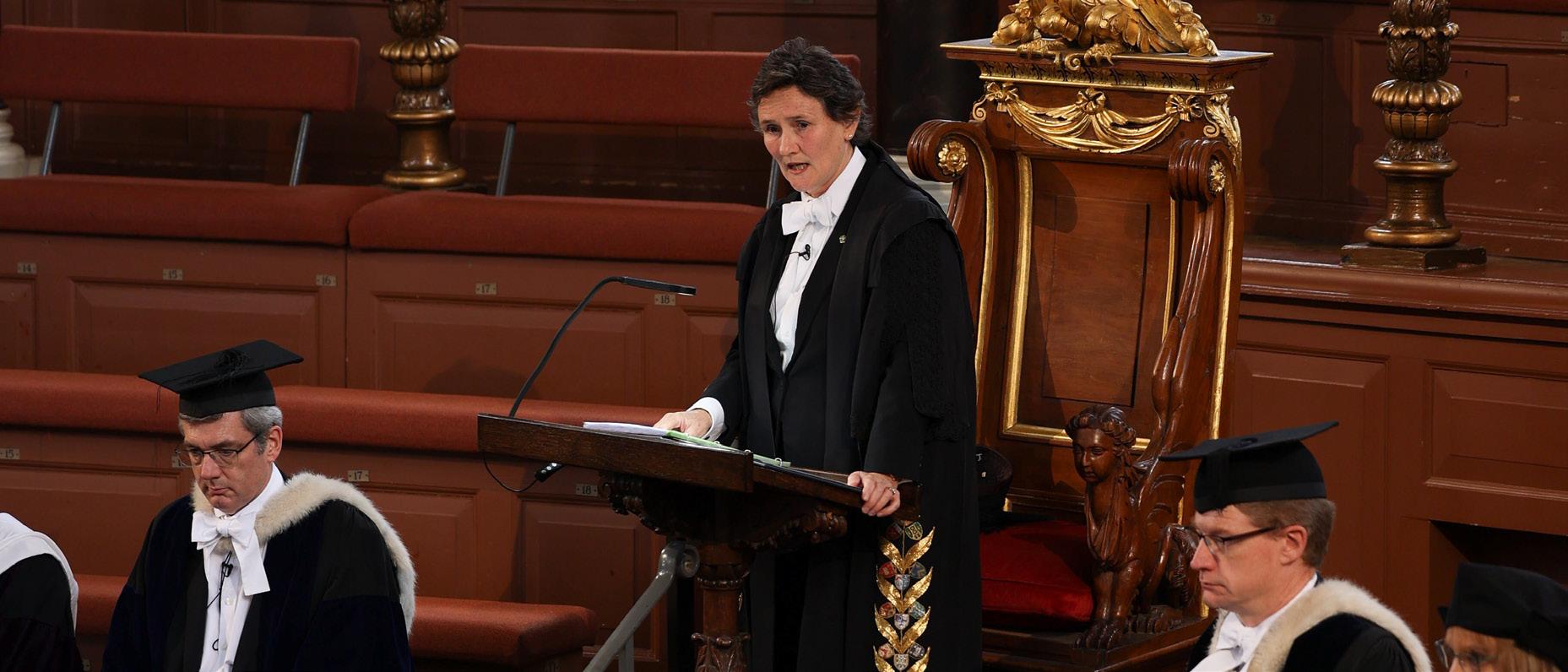
Oxford University Vice-Chancellor Irene Tracey delivered her annual Oration at the Sheldonian eatre on 7 October, setting out a vision of an institution guided by “hope, truth and kindness” amid global uncertainty and rapid technological change.
Drawing on the legend of Pheidippides, Professor Tracey re ected on storytelling as central to the human experience and to the University of Oxford’s mission.
“Storytelling is part of the human condition,” she said. “Without hope and kindness, the story of Oxford would be hollow; with them, we change the world.”
Addressing recent global events, Professor Tracey called for compassion in the wake of the Manchester attack and the continuing violence in Gaza.
“Let us hope for more kindness,” she said, “and for peace for the people of Palestine and the safe return of all hostages.”
A large part of the oration focused on arti cial intelligence, which Professor Tracey described as “a disruption or-
ders of magnitude bigger and faster than we have witnessed before.”She urged that Oxford University must help shape AI into “a trusted ally so that human and arti cial intelligence co-create a more just, hopeful and kinder society.”
She praised the University’s research leadership, highlighting projects such as the Ellison Institute of Technology
UK Education Secretary Bridget Phillipson has recently written to university Vice-Chancellors across the country to take “practical and proportionate steps” to ensure that Jewish students are protected from harassment and feel safe within universities.
and hate” and allow for “respectful debate.”
e government and Philipson’s plans to improve the safety of Jewish students within the country would entail
Centre for Doctoral Training, the Oxford Schmidt Africa–India AI in Science Fellowship and the AI in Education Hub.
“Our challenge,” she added, “is to keep humans and their stories at the heart of our existence.”
Turning to the humanities, Professor Tracey celebrated the completion of the Schwarzman Centre, calling it “a celebration of what it is to be human.”
e £185 million project, described as the largest single gift in the University’s modern history, will house teaching,
performance and exhibition spaces as well as public outreach facilities.
On climate and sustainability, Professor Tracey rea rmed Oxford University’s commitment to achieving biodiversity net gain by 2035 and reducing its carbon footprint through measures such as solar energy and laboratory e ciency programmes.
“Planet-scale problems need planet-scale solutions,” she said, citing recent University collaborations on hydrogen aviation and sustainable chemical manufacturing.
e Vice–Chancellor also noted Oxford University’s achievements in research and innovation, including a record £778 million in research income and new philanthropic gifts such as £27 million for the Oxford Centre for Emerging Minds Research. She credited these successes to the University’s “enduring, endless excellence”.
Professor Tracey addressed sta and student welfare as a continuing priority, pointing to new pay and conditions reforms, expanded paternity leave, and schemes supporting a ordable housing and visa costs. Read more online at www.oxfordstudent.com
Citing protests over the Gaza-Israel War at universities across the country and the 12 October Manchester attack, Philipson warned that Jewish students have consequently felt unsafe at universities in the UK.
e Education Secretary said she “will not allow hatred to deter students from their education,” emphasising that lawful free speech and peaceful protest need to be upheld on campuses.
She continued, “antisemitism is a poison that must be torn out from our schools, colleges and universities by its roots.”
e Department for Education (DfE) has announced that some 600 training sessions, delivered by the Union of Jewish Students, will be o ered to university sta in the next few weeks to “identify harassment
removing repeated demonstrations that are “intrusive or disruptive,” the DfE said.
rough a £7 million funding package, the government intends to teach students how to identify misinformation online and promote interfaith understanding.
Separately, £2 million is also being put towards a scheme to teach secondary school pupils in England about the Holocaust.
e move comes amidst high tensions on the Gaza War at Oxford University.
On 9 October, hundreds of protesters gathered at around 19:15 in central Oxford. Read more online at www. oxfordstudent.com
Credit: Taylor Brandon via Upsplash


Phoenix Picturehouse: House of Dynamite (18th-23rd October)
Downtown Abbey Finale (18th-23rd October)
One battle after another (18th-26th October)
e Smashing Machine (18th-23rd October)
Tron: Ares (18-23rd October)
eatre:
e Last Five Years (Michael Pilch Studio 15th-18th October)
Jane Austen’s Emma (Oxford Playhouse 20th25th October)
Uncle Vanya (Keble O’Reilly-29th Oct2nd November)
Comedy:
e Oxford Imps: Halloween special (Jericho Tavern 27th October)
O2 Academy:
e Wedding Present: 40th Anniversary tour ( 24th October) Pale Waves (25th October)
CKY ( 31st October)
Hybrid Minds: Atmosphere Uk Tour (1st November)
Goldie Lookin Chain: Still Safe As Fuck Tour (6th November) Cast (7th November)
Jericho Tavern: Los Grillos (26th October)
Jim E Brown (November 23rd)
e Monochrome Set (November 29th)
The Life and Mind building is one to the University’s largest building projects to date, having opened on 15th October 2025. is facility will be the home to the Departments of Biology and Experimental Psychology, as well as the Ineos Oxford Institute for antimicrobial research. Developed and funded by Legal & General (L&G), it will enable researchers to investigate the most fundamental questions of today; addressing topics from what it means to be human, to dealing with the global challenges of climate change, biodiversity loss, mental health, and food security.
Professor Irene Tracey, described the opening of the building as a “wonderful milestone for Oxford”, saying: “It isn’t just a world-class facility – it’s a place designed to bring
people together”.
With its opening coinciding with the new academic year, the building o ers over 269,000 square feet of spaces for teaching, research, innovation, and public engagement and will provide a home for more than 1,400 scientists, academics, researchers, support sta , and postgraduate students. It will also provide a central teaching location for around 1000 undergraduate students with its new lecture halls and teaching spaces.
Designed by internationally-renowned architecture practice NBBJ, it includes among its facilities: sleep labs, a virtual reality and motor lab, experimental classrooms, multi-sensory labs, rooftop glasshouses, and a dedicated home to the University’s botanical collections of approximately one million spec-
imens. ese facilities will allow researchers to study ‘life’ – through the natural world –and ‘mind’ – by exploring the workings of the human brain
and behaviour.
Vice-Chancellor of Oxford University, Professor Irene Tracey, described the opening of the building as a “wonderful milestone for Oxford”, saying: “It isn’t just a world-class facility – it’s a place designed to bring people together”.
Gareth Mee, Chief Investment O cer, Institutional Retirement, L&G said: “L&G is committed to putting an-
nuity-backed capital behind some of the UK’s most ambitious and impactful projects”, also adding: “ is is capital with a purpose – driving economic growth, creating jobs, and improving local communities”.
e Life and Mind Building will bring together biologists and psychologists to work on bold new interdisciplinary projects aimed at understanding how natural intelligence works and how it can inspire better, more adaptable AI systems. e building will also be home to the Oxford Centre for Emerging Minds Research – aimed at achieving better mental health outcomes for children, young people and families, thanks to a £27 million gift from e Paul Foundation.
The Oxford Student is proud to announce a new stage in its history. From this term onward, the paper will operate as an independent publication, opening an exciting chapter for student journalism at Oxford. This change strengthens our ability to pursue our own commercial partnerships, expand in new directions, and ensure that The Oxford Student remains at the heart of campus life.
A newly established board will help support the paper’s long-term stability while protecting its student-led ethos. Composed of experienced figures from journalism and entrepreneurship, as well as students, the board has stat-
ed: “We are excited to continue the work that has defined the paper since its founding: championing student voices, reporting with integrity, and
reflecting the diversity of our community. Independence brings both responsibility and opportunity, and we look forward to sharing this next stage of our journey with our readers.”

Alarge rally calling for solidarity with Palestine took place in central Oxford on the night of 9th October, with participants accusing the Oxford University of being “complicit in genocide” through its investment partnerships and institutional ties.
Organised by the group Oxford Students for Palestine, soon to be renamed Oxford Schools for Palestine, the march began around 19:15 along Queen Street and concluded in Saint Peterle-Bailey Churchyard, opposite the Westgate shopping centre.
!e event drew hundreds of attendees, joined by drummers and demonstrators carrying banners and pickets.
At the centre of the churchyard, protesters gathered around a linen mural set before the obelisk, as speakers delivered addresses.
One of the evening’s key speakers, Haya Adam, a
School of Oriental and African Studies (SOAS) student and activist for Palestine, spoke on the Gaza cease re deal that was reached on 9th October.
“May our martyrs bless,” Adam declared to a cheering crowd. “!ey have taught us what courage means, what steadfast means. Even in a world this sick, this hypocritical, this brutal, liberation will never be extinguished.”
As of 10th October, the ceasere has reportedly been implemented, with Israel said to have completed the rst stage of troop withdrawal.
Within 72 hours of the withdrawal, all Israeli hostages and 1,700 Palestinian prisoners are due to be released.
Shortly after Israel announced that it had accepted the cease re and hostage release agreement, Prime Minister Keir Starmer wrote in a public statement: “[!is] is a moment of profound relief that will be felt all around the world, but particularly for the hostages, their families, and
for the civilian population of Gaza, who have all endured unimaginable su ering over the last two years.”
When interviewed about the rally’s purpose, Adam said the demonstration was both a response to ongoing violence in Gaza and a call for student accountability.
“!ere has been an announcement of a cease re, but the Zionist entity is still bombing Gaza. Oxford University is complicit in genocide through its investment partnerships, and the UK government must also be held accountable,” she said.
e Oxford Student also interviewed a speaker who claimed to be the organiser of the event.
!e speaker claimed that Oxford University had previously attempted to prevent members from distributing lea ets during Freshers’ Week, but made a distinction between the sentiments of the university and the student body. “I want to make it clear

Image credit:
that Oxford University is not representative of Oxford. !e people of Oxford are pro-Palestine. Oxford is twinned with Ramallah,” they stated.
Crowd members responded to speeches with chants of “Shame!” and applause, many waving Palestinian ags or holding signs calling for divestment from companies linked to Israel.
!e anonymous organiser
continued that it plans to continue mobilising students in Oxford and beyond.
“We are the future,” the organiser added. “We will ght for a free Palestine, but also a free Congo, a free Kashmir, and a free world – against Western imperialism and imperialism in general.
Read the full article at www. oxfordstudent.com
Flollowing mounting scrutiny, 70 alumni of the Oxford Union have signed an open letter calling on President-Elect George Abaraonye to resign over comments he made about the recent killing of American conservative activist Charlie Kirk.
!e letter, sent to Abaraonye on Monday, was signed by former Union presidents, ofcers, Standing Committee (TSC) members and elected o cials spanning the last 50 years.
According to an ex-President, the letter garnered signatures via an email that was sent to every person who has served on the Standing Committee since the 1970s – over
2,000 people – and included a form for submitting signatures.
In the letter, alumni wrote, “[w]e come from diverse backgrounds and hold views across the political spectrum.
Despite our di erences, we are united in one exhortation.
In light of your comments regarding the tragic murder of Charlie Kirk, we respectfully ask you to resign the o ce of President-Elect of the Oxford Union.”
!e ex-President contended that “while the letter claims to represent a diverse range of backgrounds, all those who have signed the letter [and] who have publicly stated political opinion are conservative.”
!e signatories argued that Abaraonye’s reaction to Kirk’s death had damaged the Union’s reputation and deterred speakers from attending events.
Earlier this month, !e Oxford Student received screenshots, apparently from the President-Elect’s account, that appeared to show him posting multiple celebratory remarks about the shooting on WhatsApp. Among the messages were “CHARLIE KIRK GOT SHOT LET’S FUCKING GO [emoji]” and “SCOREBOARD FN.”
Abaraonye released a statement following the incident, stating that “[t]hose words did not re ect my values” and that they were “quickly deleted
upon learning of his passing.”
!e letter’s signatories denounced the statement, accusing Abaraonye of still not giving “an explicit and unquali ed apology for [his] celebration of Mr Kirk’s murder.”
!ey also condemned and acknowledged the “horri c racist abuse” that Abaraonye and Oxford’s Black and Afro-Caribbean communities have faced, calling it a “pernicious threat to free discourse.”
However, they concluded that “two wrongs don’t make a right,” and that Abaraonye’s words make him “unable to carry out the duties of the Presidency.”
In response, Abaraonye wrote in a statement: “Alumni, just like all members, can
express their views about the governance of the society. While I take their letter seriously, I also appreciate that they represent less than 5 percent of the former members of our governing body of the Oxford union over the last few decades. I am at the behest of the entire membership and all our members who have the right to exercise democratic methods when determining who governs our society, as they always have and always will.”
e Oxford Student understands that Abaraonye does not intend to resign.
!e Union cannot unilaterally remove a President-Elect. Read the full article at www. oxfordstudent.com
Opened to the academic community on October 13th, the Schwarzmann Centre is a new, multi-story academic institute housing the faculties of English Language and Literature, History, Linguistics, Philology, Phonetics, Medieval and Modern Languages, Music, Philosophy, eology, and Religion. O ering a 500-seat concert hall, a 250-seat theatre, a cinema, a black-box performance lab and a recital hall, the Schwarzmann centre fashions itself as a new take on ‘the hallowed halls of academia’.
e £185 million development was described as the largest gift in Oxford’s modern History. e centre hosts academic tutorials alongside the
wide range of faculties, and will go on to hold a range performances in its public spaces. Including star names such as Sigur Rós and Sarah Jones, and housing the Bate Collection, the Schwarzmann Centre breathes new life into the arts in Oxford.
Complete with a canteen and co ee shop, e Schwarzmann acts as a lighting rod for students coming to socialise or study. A student remarked, ‘It’s great to have such an accessible centre for students who come from colleges like St Hugh’s, it brings more people to the North of Oxford’.
Marketing itself as a centre ‘built by sustainability’ e Schwarzmann Centre aligns itself with Oxford University’s net zero carbon emissions
and biodiversity aims. In lieu of other, non-net zero friendly facilities, e Schwarzmann is the largest Passivhaus project yet, and the world’s rst Passivhaus concert hall. e ven-
ue is all electric, with solar roof panelling and biodiverse landscapes. As well as the dedication to net zero schemes, the Schwarzmann centre houses
e Schwarzman Centre
e Institute for Ethics in Articial Intelligence, displaying the venue’s capabilities of providing modern solutions to modern problems.


Agroup of around six pro-life demonstrators gathered on Cornmarket Street today to protest possible changes to UK abortion law. e protesters were from the pro-life organisation Centre for Bio-ethical Reform UK (CBR).
In June, MPs voted in favour of an amendment to the Crime and Policing Bill that would decriminalise abortion
for those undergoing it, up to birth. e amendment was tabled by MP Tonia Antoniazzi and aims to prevent women from being investigated, arrested, prosecuted or imprisoned for terminating their own pregnancies. Antoniazzi has argued that the investigations are “dehumanising and prolonged and the women forced to endure them are extraordinarily vulnerable.” She has also said that those investigated can be the victims of
domestic abuse and violence, human tra cking and sexual exploitation, or have given birth prematurely.
e protesters on Cornmarket Street claimed that the amendment to the bill will be debated in the House of Lords next ursday, though no ofcial date has been formally announced yet.
e protesters handed out pamphlets and set up two banners, including one showing an image of what was labelled a third-trimester foetus called Harriet. e second banner said: “Your MP voted for DIY abortion up to birth”, referring to how Anneliese Dodds, Labour MP for Oxford East, and Layla Moran, Liberal Democrat MP for Oxford West and Abingdon, both voted in favour of the amendment in the House of Commons.
e Oxford Student interviewed Alison, who identi ed herself as the leader of the
protest. She said: “We are here to raise awareness, to educate on the humanity of unborn children and on the reality of abortion.” She described her concern with the NHS delivering at-home abortion pills via post, something which was established on a temporary basis in March 2020 in response to the COVID-19 pandemic, and was made permanent in England and Wales in 2022.
Another protester claimed that 1 in 17 women who had at-home abortions with pills ended up in hospital. is likely refers to pro-life campaign groups’ analysis of FOI data from NHS Trusts in England, which found that 1 in 17 women who used pills by post needed hospital treatment. Organisations like the British Medical Association have expressed that claims like “1 in 17” may be too high due to the data having limitations.
Alison stated that the amend-
ment to the Crime and Policing Bill was “pushed through quickly after a 45-minute debate in Parliament”, adding: “Lots of people we’ve spoken to have no idea about this.” She also said: “We want to make [abortion] unthinkable and to o er support for those who have been involved in abortion, and for pregnant women in challenging circumstances to o er life-afrming care to them. We care for everyone, not just the unborn babies. We are not here to condemn.”
Oxford East MP Anneliese Dodds explained that it only disapplies the existing criminal law related to abortion from a woman acting regarding her own pregnancy. She told e Oxford Student: “ e amendment I voted for in June does not change any law regarding the provision of aborRead the full article at www. oxfordstudent.com
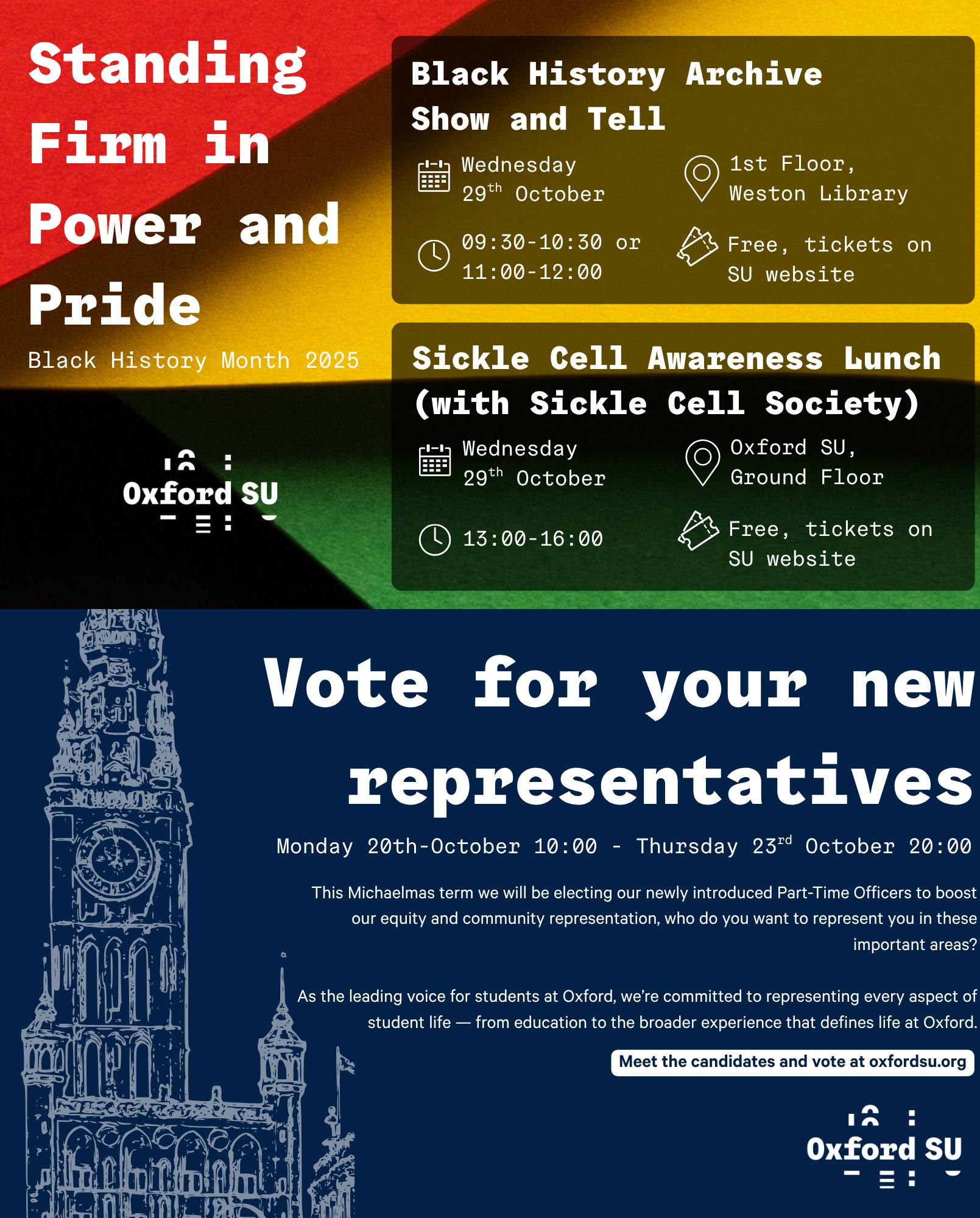

The comeback of the British Left was rather like a poorly planned surprise party. On 3rd July, Zarah Sultana posted a statement announcing… not a party. Rather, she announced that she would ‘‘co-lead the founding of a new party’’, along with Jeremy Corbyn. Only, the surprise guest was curiously absent. Not only that, but apparently Corbyn was ‘‘furious and bewildered’’ at the way Sultana had handled the announcement. Fast forward a couple of months, and there is still no party. Rather, there is Your Party, which has no policy, no leaders, and is still not a party. However, it has reportedly 600,000 sign-ups, which seems to be the only thing going for it. It’s been widely reported that the roll-out of whatever Corbyn and Sultana are planning has been messy and underwhelming. However, I think there’s more to it than that. I think it is emblematic of a kind of arrogance and hubris that is incredibly dangerous for the future of Britain.
Make no mistake, I would very much consider myself left wing. I voted Green in the 2024 general election. I’m disappointed in Labour – more than disappointed, and have been since Blair scrapped the Labour commitment to
nationalisation in 1995. Continued arms sales to Israel, disregarding the existence of trans women, a ‘labour’ party with no progressive taxation program – this is not a party I have any faith in. erefore, when I say I think a new left wing party is dangerous this is not because I’m a card-carrying Tory. It’s quite the opposite. is is not the time to fragment the British Left even further, not when the stakes are so high.
e far right has an increasingly tight grip on Europe. AfD won 21% of the popular vote
in the recent German Bundestag elections, and Italian premier Giorgia Meloni tried to prevent same-sex partners from listing the non-biological parent on birth certicates. And in the UK, we have our own home-grown threat – Reform UK. We can no longer ignore them. In the 2024 General Election, their 5-seat total is misleading, since they won 14.3% of the popular vote (putting them in third behind Labour and the Conservatives). ey’re only getting more popular, coming in at 34% in recent general election intention polls.
I nd their policy abhorrent. In their 2024 manifesto, we nd promises to ‘‘replace’’ the 2010 Equalities Act and to ban the teaching of ‘‘transgender ideology’’ in schools. ey make the claim that ‘‘the majority of mothers’’ would choose to stay at home if they could. Net Zero would be scrapped. eir o cial policy is fascist in its call for a return to a mythic past which never truly existed – traditional family values, white nationalism, ‘‘free speech’’. And this is only their o cial policy. Reform candidates up and down the country have been criticised for posting racist extremism on social media. Farage has publicly stated he thinks current UK abortion law (where abortions are legal up to 24 weeks) is ‘‘ludicrous’’. is is a party which questions hardwon rights – rights which have been in place in the UK for decades.
So, it is clear that something must be done about this threat. ere are four years until the next general election, and Reform UK is only getting more popular as Labour ounders. However, I think Labour (or a coalition of parties left-ofcentre) are the only ones who can get the job done. Sultana and Corbyn’s new scheme leaves much to be desired. 600,000 sign-ups may be impressive, but it is important to remember this is not the same as paid members. Conversely, the Labour did reach a peak
membership of over 500,000 in 2017 – to elect Jeremy Corbyn as Labour leader. However, this did not translate into electoral success. e ballot box rejected Corbyn twice in a row, with Labour giving its worst performance since 1935 in the 2017 general election. So, we know that party membership, no matter how impressive it looks, does not mean this guarantees a route to number 10.
Furthermore, we’ve seen that Britain at large does not have Corbynmania – so why are they trying to give it an-
other go?
I’m also confused about the timing of this attempt. I understand Sultana’s impetus for a fresh start was the removal of the whip, after she voted to remove the two-child bene t cap. However, it was an announcement right before parliamentary recess, a year after the general election – how does this make any sense? eir ‘party’ could have made so much more impact if it elded candidates in the 2024 general election or even the May local elections. It has been clear for a long time that Sultana and Cor-
byn’s views are to the left of Starmer’s Labour. e timing of this ‘shock’ to British politics is another sign that it was poorly planned. e thing that concerns me most about Your Party is what it says about its leaders. Since the UK operates with FPTP for parliamentary elections, it is very unlikely that Sultana’s scheme will ever be a threat to the Commons heavyweights. Perhaps it will steal seats where the Greens or independents have won before. But it will leach seats in constituencies where the battle is between Reform and a lesser evil. And if voters defect from centre-left parties to this new party, the fear is that Reform will be victorious. Corbyn and Sultana know this is how British politics works. I’m all for voting for smaller parties in some elections – like I said, I voted for the Greens last year. is is because I was condent Labour would win, and I was in a seat that was safely Lib Dem. I felt I could safely protest Labour’s rightward creep, without fear that I’d let a greater evil get through the backdoor. I don’t think the same situation is going to arise in 2029. Instead, I predict I’ll have to swallow my tongue and vote for a Labour party I don’t believe in (or Lib Dem, if I still live in their South West stronghold), to prevent Reform getting into Downing Street.


If you’d missed it, Peter iel, co-founder of Palantir, PayPal, major voice in the Facebook/Meta evil empire, and melting waxwork body of the Antichrist did an interview in which he re ected on his career and what he saw as the major questions facing our society. e most worrying part of this interview, beyond the fact eil’s mortal prison may be being destroyed as you read this, was that Peter eil could not conclusively say that the human race should continue. Not only does he have the cheek to bastardise Tolkien, but does so with none of his whimsy and with enough fatalism to make Sauron blush. Why is it so concerning that
this latter-day Lord of Evil fails to nd himself supportive of humanity? Because, in the 2010s, he represented STEM’s successes at its peak. is isn’t a condemnation of STEM students. ey work in-
credibly hard, long hours, devoting themselves to the betterment of humanity through the research or work they do, and they are thoroughly good people. It is a criticism of the view spread by an over-
whelmingly American circle of billionaires that only such STEM degrees have any value to the world. iel is part of that crop of big tech CEOs that began making their way into the world in the late 90s and early 2000s. e most famous of them, at rst, were Bill Gates and Steve Jobs, before Gates became the bete noir of the right for his radical insistence children shouldn’t die of preventable diseases, and Jobs’ sense of superiority drove him to pick a ght with one of the few threats humanity hasn’t conclusively beaten yet: cancer. In their wake came the CEOs we’d begin to associate with the ‘Big Five’ tech companies, who survived the dot.com bubble at the
turn of the millennium. Mark Zuckerberg, with his own movie and charmingly reptilian personality, was foremost amongst them, before Je Bezos and his billions of pounds in plastic surgery and space- ights stole that public title from him. Tim Cook took over Apple in the aftermath of Jobs’ death and has been the most ‘normal’ of the CEOs in his behaviour, self-interested in a corporate sense but without the accompanying feeling of shame. Elon Musk has, like many an Oxford PPEists’ summer internship, spent a few months in government, and now faces threats of deportation and the tarring of his Tesla, Starlink and SpaceX successes through his current misadventures. A coterie of positively clown-like capitalists to consider who, like eil, are praised as the icons of a modern grind culture of success. But when they’re invited to give graduation speeches, or discuss what made them their millions, there’s a consistent thread shared by most of them, bar Gates. It is their relentless praise of STEM degrees, and their thinly concealed loathing for the humanities. rough their apps and platforms, relentless slating of such academia by infantilising those who study it, promising unemployment as the only outcome students will face, and attening of the subjects into thin pop culture renditions, as has been the unfortunate fate of the Emu War. e humanities are made out to be a grey wasteland of aspiring baristas, teachers and emotionally unstable artists. Valueless debt holes into which money disappears, and nothing of worth is produced. STEM degrees, particularly computer science degrees, and nance, are the weapons of modern progress according to the titans of tech, science and capital, securing passage into an elite in-group that will place you above all those who mocked you on the on the playground, and nally make you ‘cook’ in a way that they argue Michael Bay movies, explosions and copious uncooked meats can. Studying the humanities and arts produces the works of
culture and literature that fascinate and make our life interesting, makes our society more culturally diverse, which I would challenge anyone to call negative a er a brief experience of the cuisines and cultural products of the world. A world without these works would be staid, boring and fundamentally unstable. A world devoid of literature, of cinema, of theories and music is a world I would not want to live in. One which wouldn’t survive as each generation would be a cooky-cutter copy of those that came before, shaped only by the unceasing grind of work. Making the humanities and arts appear out of touch and nancially unsustainable attempts to shutter them away from the working class, and rob communities of their cultural colour. If you look into the histories and stories of the scores of nations past, it is their achievements outside the worlds of science which shape our understanding of their civilisations and lives. Stories re ecting the cultural zeitgeist of their time, artworks giving us a window into eras long gone. A focus solely on raw, numerical value leaves us with an atomised society, one which will leave no legacy and demonstrate nothing to the generations that follow of what tropes and values we hold dear. Humanities are just as valuable as STEM. Education of any sorts should be praised: devaluing humanities doesn’t just hurt students and professors in these elds, but wider society by making life thinner, duller, and less interesting.

state, Adivasis make up 100 million of India’s population. When she rst arrived, there was little access to healthcare or education, and the literacy rate among Adivasis in the villages where she lived was 10 percent.
“But that’s not to say that they weren’t amazing intellectuals,” Alpa says. “ e indigenous people there have ways of life that are far more environmentally sustainable, and I think we have a lot to learn from them. Although they’re really poor, they’re also extraordinarily wealthy in terms of what they have to teach us about living in the world.”
nessed rst-hand the transformation of Adivasi land. Her rst book, In the Shadows of the State, explores the lives of these Adivasis – their ideas of democracy, ecology and mobility. Her second book, Nightmarch, documents her time spent in the guerilla strongholds. “I tried to understand how and why this guerilla movement had spread, and how it falls apart from outside but also from within”, she explained.
Her most recent book, e Incarcerations, began during the COVID pandemic, after a call from the editor of Nightmarch who was based in India. “He said that things were really, really bad there, and that we really needed a book on the arrest of professors, lawyers, and journalists in India. And he said to me that no one there could write this book because everybody who was writing about these issues was being persecuted.”
can’t write a book about colleagues being imprisoned and losing their lives?’ And so I started writing e Incarcerations. It’s a book about their lives, the work they’re doing and why they were put in prison by the Indian state. It’s about how they were framed. It’s a book about the collapse of democracy in the world’s largest democracy.”
Ultimately, Alpa’s work is about uncovering hidden truths and bringing light to worlds that have been marginalised. Without e Incarcerations, many Indians would have simply assumed that the imprisoned people were terrorists due to the government and corporations co-opting the mainstream media. e book humanises them and shows how they were working for the rights of not only Adivasis, but other minority groups in India.
Alpa Shah is a social anthropologist and fellow at All Souls College, whose immersive eld research among indigenous people in India spans three decades. She is the award-winning author of In the Shadows of the State: Indigenous Politics, Environmentalism and Insurgency in India (2010), Nightmarch: Among India’s Revolutionary
Guerillas (2018), and e Incarcerations: BK-16 and the Search for Democracy in India (2024), which was shortlisted for the Orwell Prize for Political Writing.
Since 1999, Alpa’s research has involved living with groups of Adivasis, indigenous Indians living on the margins of society in the forests of central and eastern India. Historically neglected by the Indian
Tragically, Adivasi lands became a war zone. From 2006 onwards, the Indian state deployed hundreds of thousands of troops to surround their forests. ere were rich minerals such as coal and bauxite beneath the land, which multinational companies wanted to extract, and so did the Indian government, which recognised this nancial opportunity. Despite legal protections, the Indian state displaced Adivasis by declaring war on banned left-wing armed guerillas, known as Naxalites, who also lived in the forests. ese guerillas, who emerged from a 1960’s rebellion in Naxalbari, followed a Marxist-Leninist-Maoist ideology. Labelled terrorists, they provided the state with justi cation to raze villages, kill ordinary people, and present them as killed terrorists to the rest of India.
Having arrived at the turn of the millennium, Alpa wit-
Initially hesitant, Alpa worried writing the book might bar her from returning to India. But the case was too urgent to ignore.
Known as BK-16, the case involved unexpected police raids on the houses of 16 professors, lawyers, poets and artists across the country, some of whom Alpa knew very well.
e book describes how the police seized all their electronic devices and declared them terrorists across the national media. Authorities declared they had been inciting violence and were even plotting to assassinate the prime minister. ey were incarcerated without trial, and years later, many remain imprisoned. Among them was an 83 year old Jesuit priest who had worked on indigenous people’s rights. A few months into imprisonment, he caught COVID and died in judicial custody.
“His name was Stan Swamy. at was the last straw for me.
I asked myself: ‘What does it mean to be an academic if I
“What you see in India is a playbook of authoritarianism that is now unfolding globally. e lives of young people are being corrupted by the far-right and how the far-right speaks to them. We need to think about these issues now.”
inking about the sense of political duty which motivated her to write the book, I asked her about the relationship between politics and academia, especially given her deep engagement with revolutionary groups. “ ere is no such thing as objectivity,” was her answer. “But my responsibility as an anthropologist is to o er as deep, honest and integrated a perspective as I can.” While Nightmarch, for
instance, is deeply sympathetic to the revolutionary hopes and dreams, it is also a deep critique of them.
“ e Naxalite movement, as awed as it has been, has also inspired the ght for justice and a more equal world in a country which is very hierarchical and unjust. And every few decades, when you think it’s over, it rises again like a phoenix. e revolutionary spirit remains in the Indian imagination.”
Alpa emphasises how anthropology, unlike other disciplines, is rooted in ethnography – long-term, immersive eldwork. It sets aside hypotheses and tries to under-
stand people holistically. Alpa told me: “We try to study all the aspects of people’s lives because we believe that there will be unanticipated connections and insights. Life isn’t separated. And moving past that idea is how you get new revelations. We say it makes the familiar strange and the strange familiar.”
“It’s the only subject which makes you take other people who are not the same as you very seriously. It’s the only subject which makes you question everything you know through the lives of others.”
Read the full article online at www.oxfordstudent.com
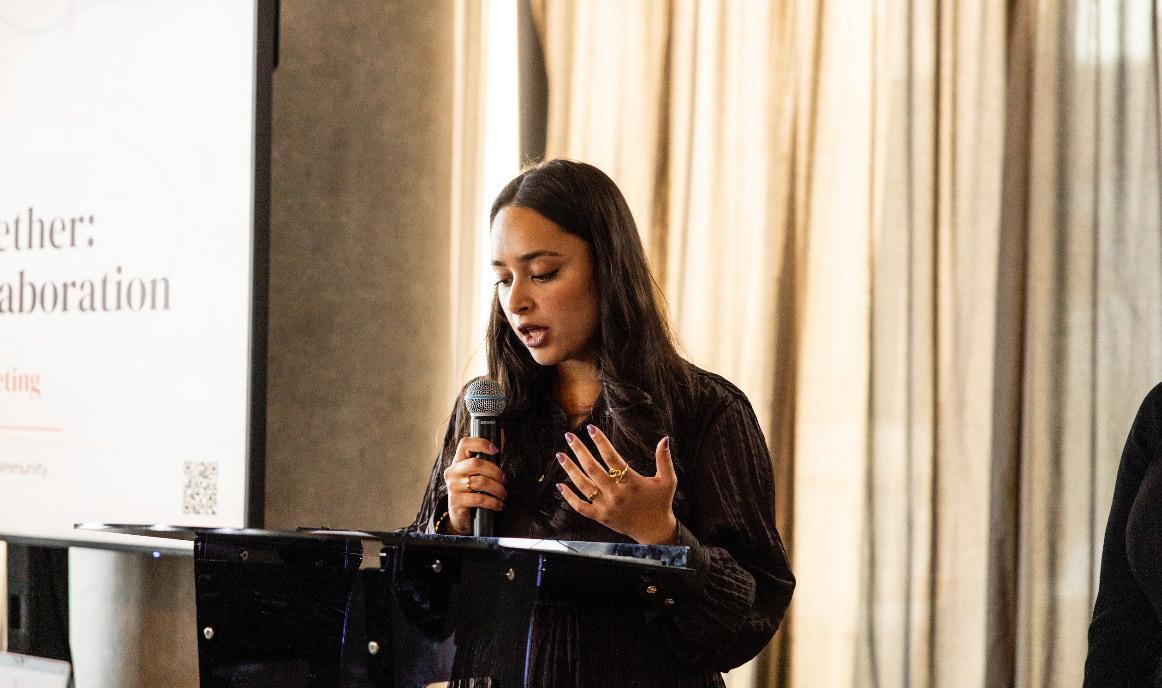
Week 0 of Michaelmas always brings a particular buzz to the city. Bright-eyed freshers arrive in Oxford brimming with excitement and anticipation, while returning students spill back into town, sunwarmed and eager to recount the tales of their summer adventures. Yet beneath the surface lies a troubling reality: the rst few weeks of university are often referred to as the ‘Red Zone’ – the period of highest risk for sexual assault among students, especially rst-years. It’s this reality that Jasminder Sekhon, an expert in gender-based violence prevention, brings to our conversation one bright autumn morning.
Jasminder completed her MSc in Criminology and Criminal Justice at St Catherine’s college in 2018. Since then, she has founded GEquity Consulting, a rm dedicated to advancing gender equality across institutions in Canada and abroad. She also leads workshops on consent – an issue deeply personal to her, having experienced sexual assault herself during her time as a graduate student. When people picture sex-
ual assault, Jasminder says, they often imagine a stranger “jumping out of the bushes”, doing something terrible, and the victim “ ghting or running away”. at’s why, when she fell asleep on her friend’s dorm room oor, she never imagined she would wake to nd herself being sexually assaulted by him.
hundred percent sure.”
Speaking about the ‘Red Zone’, she points to a myriad of factors that heighten students’ vulnerability: “being in a new environment, the social pressure to experiment, or to drink in a way that you may not have before”. She believes “the duty falls on universities and colleges” to ensure that students are safe.
“In the UK, around 85 percent of women are sexually assaulted by somebody they know,” she notes. “ at gure is about 50 percent for men. And that’s speci cally for sexual assault by penetration.” “ is is a gendered crime,” she adds, “where women and gender-diverse people are more likely to be impacted.”
To those who have experienced sexual assault, Jasminder’s message is this: “No matter what happens, it’s not your fault, and you deserve support. If you think something happened, talk to somebody – even if you’re not a
Her approach to conversations around sexual violence is sex-positive and intersectional. She sees sex “not necessarily as something negative or something to be stigmatised”. “For many people, there’s a lot of joy in sex,” she says, “and it’s important to acknowledge that.” She emphasises the need to understand that “those from socially or economically marginalised groups may be more likely to experience sexual violence”. She also notes that while people in the UK talk a lot about spiking, they overlook the fact that “one of the most common date-rape drugs is simply alcohol itself”.
Our discussion turns to the legal frameworks surrounding sexual assault. Jasminder references her friend and colleague Shannon Russell,
who is completing a DPhil at Oxford’s Faculty of Law on the constructions of rape and sexual violence by the law. “Shannon talks a lot about the complexities of having a criminal charge that is rape, versus one that is sexual assault,” she says. Legally, the term ‘rape’ is very speci c, referring only to penetration by a penis. “It excludes a lot of very violent sexual acts, and it’s not very gender inclusive either.”
Canada took a di erent approach in 1983, when it removed penetration as a re-
ing the role of penetration in sexual o ences in Canada, Shannon argues that “a penetration-centred model” such as the UK’s “rei es gendered and heterosexist assumptions about sexuality”, whereas “the Canadian approach is more e ective [...] at communicating the gravity of the wrongfulness of sexual assault”.
Before we part, Jasminder leaves a nal message for all Oxford students: “Sexual violence doesn’t just happen in a vacuum – it’s situated within a broader rape culture that justi es, excuses and trivialises it in many ways. We, as a society, need to recognise this reality and shift towards a consent culture – a culture in which people feel safe and comfortable; where jokes about sexual violence are not brushed o .”
quirement for sexual assault o ences. e reformed framework speci es varying degrees of sexual assault, determined by factors such as physical contact or the use of violence.
In her master’s thesis, Explor-
“We may not all have an opportunity to interrupt a sexual assault, but we all do have the opportunity to disrupt the foundation that allows sexual violence to take place. Every student here at Oxford must play a role, and should feel empowered to speak up any time something like that happens.”
Read the full article online at www.oxfordstudent.com



To anyone. outside the Oxford ring road, ask for an Oxford college and a few famous names might crop up. Christchurch, with its meadows and vast quads, Magdalene’s deer, Brasenose’s recent appearance in Saltburn or Balliol’s penchant for producing Tory politicians. But mention the humble Lady Margaret Hall, or the lesser spotted St Peter’s, and you’re more likely
to be left with blank stares than a burst of reminiscence.
Oxford’s public profile is dominated by a few of its more than thirty separate colleges. These colleges tend to be older, and wealthier, than the average, although St John’s relatively low profile conceals its Scrooge McDuck-esque wealth. Smaller, more modern colleges struggle to receive appropriate recognition for their virtues beneath the shadows, both literal and metaphorical, cast by these dominant few. Their alumni lists contain fewer Archbishops and Prime Ministers, their halls were built
in the 1960s, not the 1460s, and they’re scattered around the periphery of the town, far from the nucleus of the university centred around the RadCam.
But the root of a college’s issues is not necessarily because of its relative youth, or lack of notable alumni.
Some are just remarkably unremarkable. Such is the case of University College. Univ is debatably the oldest college at the university, though the college initially stood on what is today Brasenose, before moving to its current site in the 14th century. The current buildings date from the 17th century, with the only relics defending Univ’s claim to the title sequestered within the senior common room, for dons to admire. Main Quad, Rad Quad, the library and both the hall and chapel are gorgeous spaces, lovingly designed and built and show the weight of the college’s history.
83-85 and 90-91 High St are
better left forgotten.
Its alumni include Clement Attlee, a former Labour PM and founder of the modern welfare state, as well as former President Bill Clinton and Bob Hawke the Australian PM who was rumoured to hold the Oxford record for the fastest time to drink a yard of ale. John Radcliffe, namesake of both the library and hospital, studied at Univ – his money built the core of the college seen today. Felix Yusupov, the man who shot Russian eminence gris and hit single Rasputin, was a member here, whilst Fetus Mogae, Percey Shelley and C.S. Lewis all graced the college for a time.
It’s not a shabby list, and the college is located a short stroll from both Cornmarket St and Magdalene Bridge. But yet it, like many a beleaguered ‘Saint ____’s’, suffers from a lack of recognition commensurate with its position and age. Merton, despite its recent Prime Ministerial alum, Corpus Christi and even New College are surprisingly little considered. If these sizable, veteran colleges go unnoticed, what hope do Pembroke, Mansfield and Harris Manchester have?
Univ lacks much that truly stands out. There’s the Shelley Memorial, but it’s been caged away after students had too much fun, which couldn’t be allowed (though some sources say these bars have since been overcome). Our library is nice, but save for the dominant presence of Lord Eldon and his brother’s statutes, it doesn’t compare to others. Univ’s just normal - everything you’d expect
from an old college. Even the name is normal.
And that’s the most brilliant thing about it. It’s not a college caught up in a myth of
itself, or a burdensome legacy to uphold. Univ is a lively, vibrant space, as are many of the colleges beyond the narrow, famous few. Its college sports are friendly and competitive, its societies safe spaces away from the bustle of life outside college walls, more normal than spaces self-conscious of their status. Those more outwardly prestigious colleges are the right place for some people: they had, and continue to have, incredible students. But for all colleges whose name might less often spring to the popular mind, we can take heart in the fact we are independent spaces, less burdened by what has been as what could be, filled with dynamism and activity. If every college were a cultural touchstone, it’d be exhausting, and boring. The differences in each college make Oxford a rich patchwork tapestry – one we’re privileged to enjoy, regardless of if you live on the High Street or Summertown.
The lack of kitchen facilities at Oxford means hard-done-by students like me have to scour to create half-decent meals using microwaves, kettles and air fryers that are only remotely reminiscent of comforting oven-cooked food from home. I’ll concede this unfortunately does make some sense – in Oxford the older buildings were clearly not originally designed for kitchen space – but considering other more modern universities across the country, do we still need to be held back by the student cooking facilities of the sixteenth century? I think not. While I start this article on a blunt note, all is not lost. Even though my college, Keble, doesn’t allow access to kitchen space until third year for most, some sneaky students can get away with hiding air fryers in cupboard space, tucked away for no scout to !nd so that they can concoct something resembling a meal. ere is also always reliable hall food… even if it costs an arm and a leg and features the same variation as one bland single to the next on Taylor Swift’s recent e Tortured Poets Department album. Oxford does have a lot of choice when it comes to food,
but whether it is cheap, reliable or !lling enough, that’s to be debated.
Let’s start to unpack kitchen-less meal life at Oxford… Breakfast, for example, is easy to solve. Having to scramble for a quick energy !x when dashing out for an early morning lecture doesn’t really call for a kitchen. Bizarrely found in your kitchen-less staircases, microwaves become your lifeline . A favourite of mine is porridge, even if it becomes repetitive after a while; it’s just what I need especially on those wintry Michaelmas mornings. Unlike Exeter College, Keble does have fridges from !rst year onwards. is has meant I can refrigerate milk, fruit, yoghurt, the list goes on!
When it comes to lunch,
is week, I moved into college for the last time. Lugging hordes of crates, bags and plants up three ights of stairs isn’t the most glamorous start to my !nal year, but it’s !ttingly bittersweet. ird year is bittersweet. As I move into obscurity, I can see freshers nervously introducing themselves and second years replacing the roles we !lled just a year ago. A stranger sleeps in my !rst year room, admiring the same owering tree, using the command hooks I pressed into the walls, banging their head on the same shelf (photo evidence will be denied). A second year, free of freshers’ fears, is covering up the chips
again, all is not lost for students without kitchens. I would argue most students either prepare lunch (pasta, sandwiches, soup etc.) or buy out in the city. While to-ing and fro-ing from lecture to seminar to tutorial and back again, taking a pit stop in Taylors or grabbing a Tesco Meal Deal was a common occurrence in my !rst year.
During the !rst few weeks of Freshers, hall dinner was de!nitely a lifeline when trying to meet new people. After a term though, these dinners, informal and formal, became predictable. is led me into the realm of microwave meals, despite being full of added preservatives, these were the easiest solution instead of paying upwards of £6 for each hall meal. But is this really su cient fuel for university
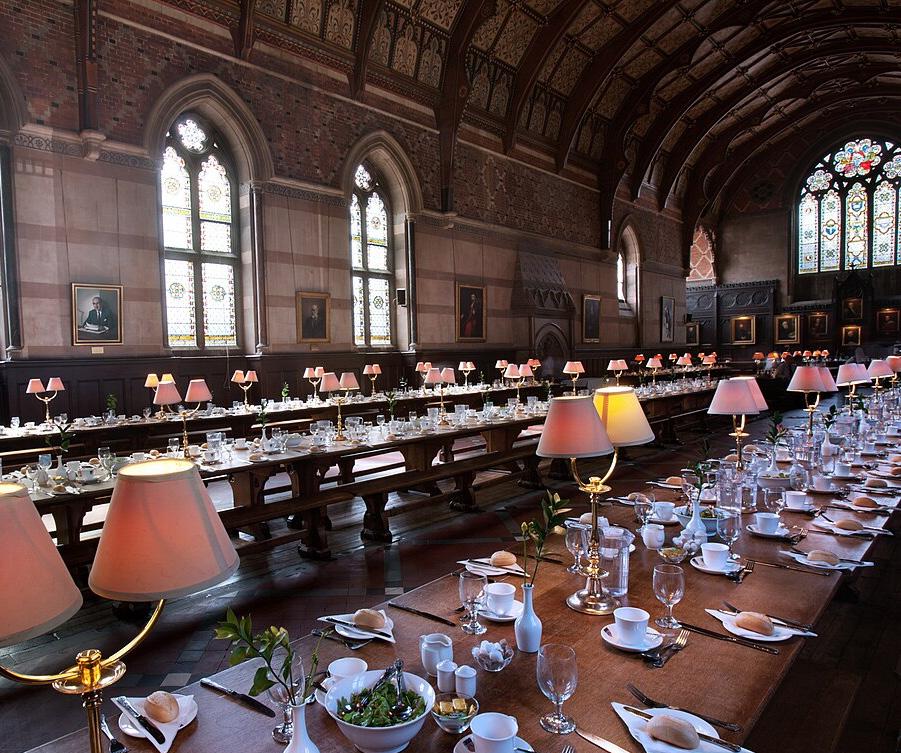
Keble Hall © Jorge Royan https://creativecommons.org/licenses/by-sa/3.0/
students so constricted by both time and budget? I certainly didn’t fully understand the reality of kitchen-less living before arriving in Oxford.
With or without kitchens, students across the country are united in the struggle against poverty and time. In the BBC article titled ‘What do students really eat?’ ,Hamish Mackay noted that UK students are !ghting to keep costs low during these economically troubled times, resorting to ‘incredibly varied’ meals, often lacking in nutri-
ents. Convenience is the name of the game for modern students.
All in all, it’s true that I naively underestimated the reality of a kitchen-less life before coming to Oxford. I could argue that, like my academic degree which sometimes makes me question my career prospects, the kitchen-less culture in Oxford also fails in giving its students the skills needed for the ‘real world’ outside of university.
of paint in my grey room with posters, using my bedside table for books and chargers, enjoying the view my parents loved.
In my second year, I always wondered why third-years seemingly disappeared from public life. ey were like rare animals; only spotted in the cold corners of libraries or hungover brunches. In my third year, my question was silently answered. If it’s any indication of how my fresher’s week played out, I didn’t realise my bod card didn’t let me in the library until the middle of !rst week. is year, older and wiser, I’ve spent so much time slumped
over a desk in the Humanities Centre the baristas recognise me.
Over the course of this year, our names and faces will slowly disappear from committees and societies, our only legacy being a white-tak stain on a wall or a mention of a college grandparent. I’ve noticed a silent but dutiful change in myself, almost an acceptance that this is it. e end. All good things have to come to an end, so the least we can do is accept it with some dignity. Our club nights, once spontaneous ights into the night, are now carefully planned. A 9am tutorial on a ursday after Atik Wednesday was sim-
ply a sacri!ce for tomorrow morning to deal with. Now, me and my friends spend our nights trying to hang bunting in our shared kitchen. e reality of third year is a tough one. We’re reaching the end of what many consider the most formative and brilliant years of their lives with barely anytime to enjoy it. Deadlines or dancing? It is an age old question, and one that will hopefully outlive my time at Oxford. Anyways, who’s up to Reggaeton?
Having graduated from Oxford with a degree in Archaeology and Anthropology, Helen Greetham (also known as ‘Jabbage’ online) began to look for a career which would allow her to combine her passion for education with her creative nature. Although she had initially considered museum education, the t did not seem entirely right at the time. Nonetheless, she managed to nd a small niche in making comics and illustrations in the museum and educational charity sector.
By 2020, she was considering publishing her own comic book or graphic novel, having also found full-time work as a digital education specialist at university library services, a position she still holds. “It’s a very varied role,” she says. “I nd that it gives me the men-
tal space to also fancy doing creative things in my evening.”
During those evenings she’d work away at making ‘pitch packets’ to send to her agent, hoping they would be picked up for a longer graphic novel. But, more often than not, those would come back as last-minute rejections. “I realised that I was putting a lot of work into this but not actually producing anything,” Helen remembers. To prevent herself from becoming completely discouraged, she set out to work on what she describes as “the most self-indulgent project I could imagine.” “It needed to not be a comic, because when I was doing comics, I was inevitably thinking about whether I could sell them or not. And that was not what I wanted.”
She had recently rediscovered her love for Arthur Conan Doyle’s universally acclaimed Sherlock Holmes novels, and as a long-time fan of point-
and-click video games, the idea of making some of the beloved characters come to life on a computer screen instantly seemed appealing. “I am sort of a techy person and that’s kind of my day job, so I think it just started out as ‘Oh, I’m just gonna have fun making something really short, like a character walking around.’ Eventually all comic things dropped o because I was just having so much fun working on this project.”
e project in question was nally released on Steam in March 2025 as ‘ e Beekeeper’s Picnic’ – a cosy point-andclick adventure game featuring a retired Sherlock Holmes trying to set up a picnic to celebrate the return of his esteemed Boswell, Doctor Watson. But Holmes nds himself with plenty of mysteries to solve, as not everyone in this sleepy seaside town is who they claim to be.
e game has since received
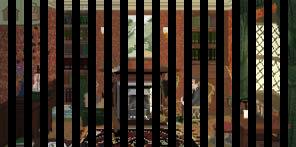
numerous accolades, including being listed by Kotaku as one of their Games of the Year So Far, mentioned in Cosmopolitan Magazine and the Financial Times, and currently rated 9/10 on Steam.
Having decided to explore some less commonly discussed facets of Sherlock Holmes’ character – his retirement, his complex and intimate relationship with Watson as well as the detective’s more emotional side – Helen felt a bit wary of the stories’ extensive fanbase.
“It comes with both a bless-
ing and a curse. On the one hand, I think it did sometimes lead to the game getting more attention because people could pass it on to their friend who likes Sherlock Holmes, so it basically came with a ‘ready built’ community. On the other hand, people have pop culture ideas of what Sherlock Holmes is and what he should be doing. And that doesn’t often involve him being a retired beekeeper.“
Read the full article at www. oxfordstudent.com
Have you ever wished that NHS workers were paid more, or you didn’t have to spend so much on gas?
Bloomberg News reporter Joe Mayes’ latest game-style novel Can you run the economy? challenges you to survive as the UK chancellor. It’s entertaining. It’s educational. And it’s mildly endearing. ere are two parameters that determine calling No. 11 your home: your approval rating and the budget surplus. You begin with an approval rating of +10 and a budget surplus of 20 billion, which is more than most chancellors these days. Maintaining a positive value of both is essential
to succeed in your term as chancellor, for your party to then win the general election. 15 pages short of the end, I was dismissed because my approval rating was a -13. e public clearly thought I was unlucky. Can you run the economy? is a read-in-a-day book, with a high educational value to time ratio to understand how the British economy works. I would especially recommend the book to an amateur in British politics like me. And, if as a political savant, you have doubted your ability to run the economy, this should be your next read.
e idea for the book came from an interactive game that was made for Bloomberg about the Treasury for the purpose of explaining how the budget works in a “fun, easily
accessible, and engaging way”. Some of these concepts can be dry and di cult to explain in writing, but a game format has made it a lot more fun and accessible. When asked if a lot of the mistakes highlighted in the book were from the Liz Truss period, Mayes responds, “I’ve been covering the Treasury for the last four or ve years, and that’s when Truss was a part of it. But it’s not just that.”
e ritual of ring the chancellor is like the end of a modern situationship. A period of ghosting and lack of communication from the prime minister, and then down comes the guillotine.
Politicians don’t precisely have the reputation for being pillars of truth or honour. Not unlike a few people we all know that are undoubted-
ly going to go on to capture the votes of the British public. What’s a lie they all had in common? “It’s not quite a lie, but it’s something that frustrates me regularly as a journalist. It’s how the government uses statistics around numbers to make things sound good, but they don’t give you the full context around that number.” What might seem like a large sum to the public is just a
rounding error on government nances towards a project. To aspiring politicians, Mayes recommends gaining a comprehensive understanding of the policy world. “Get comfortable with the very practical realities of what governments can and can’t do to address legislation.”
Read the full article at www. oxfordstudent.com

This year, 16th December marks the 250th birthday of Jane Austen, renowned for the lasting impact her six novels have had on English literature. Jane Austen’s novels are perhaps the most prominent cultural relic of the Regency era, owing to the immortalisation of contemporary fashions, social practices and linguistic conventions within their volumes. At !rst glance, Austen’s novels are simple, pastoral love stories with personable female protagonists and satisfying (if predictable) endings. Beyond this, they are also piercing satires of the society in which they were produced, critiquing the interactions within families, communities and romantic relationships, and highlighting the di culties women faced in those environments.
I was !rst drawn to Austen’s novels by the compelling romances which lie at the heart of each story. For me, their age was an aesthetic asset rather than a cultural barrier. But life in the 21st century arguably bears few similarities to that in the 19th, with social dynamics, gender roles and class structures having drastically transformed over the past few centuries. Accusations of waning relatability are not without reason. How does a satire of a society which no longer exists remain relevant to this day?
To be sure, romance has evolved over the course of time: in lieu of the demure, monogamous courtships of old, we now have dating apps, one-night stands, and situationships. Aside from how we date, there is also the matter of who we may date. In Austen’s time, queer romance – whilst certainly not nonexistent – was prohibited by society and law. It is only within
the last quarter of a century that homosexuality was fully decriminalised in the UK, and it is scarcely a decade since same-sex marriage was legalised, but queer relationships are accepted for the most part within our society today. Austen’s novels re ect the conservative society within which she wrote, and do not represent the diversity of modern relationships.
past are not truly erased from our collective consciousness. Likewise, love and heartbreak have hardly changed; scandal and melodrama are far from extinct.
Any long-su ering victim of the pernicious ‘situationship’ will understand Marianne’s devastation in Sense and Sensibility when Willoughby ignores her letters and denies they were ever even together. ere is also a perpetual appeal to Elizabeth and Darcy’s mutual self-improvement journey in Pride and Prejudice, inspiring envy in anyone who regrets a past proclamation of “I can !x him!”
One recurrent criticism levelled at this rebrand is that it is degrading to compare Jane Austen’s work to mass-produced BookTok slop. Full transparency: my gut reaction was to share this sentiment. But on subsequent re ection, this censure is misguided. Disdain for the perceived intellectual or moral value of romance novels follows a long tradition of misogynistic dismissal of the overarching genre. Whilst Jane Austen’s books are heralded as great works of literature today, at the time of writing, romance novels faced just the same
Similarly, Regency society was often disapproving of inter-class pairings. In Persuasion, Anne Elliott is convinced not to marry Captain Wentworth due to his inferior social and !nancial status, in spite of their passionate feelings for each other. Whilst economic considerations may still impact our choice of partner today, the vast majority would think it ridiculous to reject someone based on their social “status”.
Yet, beneath their dated contextual veneer, the stories Austen told are no less relevant to romance today than the day they were written. Whilst conventions of Regency society are deeply entrenched in her bibliography, Jane Austen wrote primarily about people and relationships, and neither of these things has fundamentally changed over the past two centuries. e constraints of society which she criticised may have faded to some degree, but the footprint of past generations still marks our relationships today. e pressures and prejudices of the
Nevertheless, the enduring pertinence of Jane Austen’s social commentary has not curbed attempts to update her novels for the 21st century. Penguin Random House’s Pu n imprint received impassioned (if not widespread) backlash earlier this year, after announcing a new ‘First Impressions’ range of Austen’s novels. e ‘First Impressions’ editions were intended to engage the Young Adult market, featuring forewords by prominent YA romance writers such as Ali Hazelwood and Hannah Grace, and sporting the signature cartoon-style covers.
criticisms as they do today – they were seen as the frivolous, low-brow pastime of women and girls, alleged to
have a pernicious in uence on their minds. Jane Austen criticised this herself in Northanger Abbey, and praised novels as “work in which… the most thorough knowledge of human nature… the liveliest e usions of wit and humour are conveyed to the world in the best chosen language”. In light of this, it seems rather ironic to object to Austen’s works being compared to modern-day YA romance. Of course, I don’t imagine that the publishers’ intention was to highlight society’s ongoing denigration of traditionally feminine media. Nonetheless, I can’t help but feel that Jane Austen would have appreciated the irony of the situation. Jane Austen’s novels have never been irrelevant, so it seems ridiculous to try to modernise them in such a gimmicky and misrepresentative way. Modernisation can be done well. Bridget Jones’ Diary (2001) and Clueless (1995) reframed the plots of Pride and Prejudice and Emma respectively, in a contemporary setting. As well as being creative modern adaptations of Austen’s novels, they are excellent Read the full article at www. oxfordstudent.com

e Talented Mr. Ripley, starring e Crown’s Ed McVey, is showing at the Oxford Playhouse from 13th to 18th October.
e Pat Suet-Bik Hui and the ree Perfections exhibition is ongoing at the Ashmolean Museum.
e Suzanne Treister: Prophetic Dreaming exhibition is currently showing at Modern Art Oxford (4th October-12th April 2026).
A John Le Carre: Tradecraft exhibit is running at the Weston Library until 6th April 2026.
e Camera Helps, a Paddy Summer eld exhibition at Weston Library, runs from 11th October
eatre Royal Bath Productions’ Emma shows at the Oxford Playhouse from 13th-18th October
Oxford eatre Guild’s A Doll’s House shows at the Old Fire Station from 20th-25th October.
“
Do you ever get the feeling that you’re being watched?”
Tom Ripley says, while the audience quite literally looks over his shoulder, as he sits with his back to us. It’s a sentiment he returns to throughout the play; and true, he can never escape our gaze, nor that of the shadows in the darkness (played by synchronised extras in detective-wear) that stand watching, waiting.
e Talented Mr. Ripley (1999) is one of those lms whose iconic scenes stay with you: green shorts, a rowboat, the opera... Adapted and directed by Mark Leipacher, the stage adaptation reimag-
Towards the end of the novel Flesh, István, the protagonist, is caught up in a conversation about his past, with a woman he just met. He is reminded of the greatest nancial and familial scandal of his life which forced him to move back to Hungary from England. With the impending release of e Booker Prize 2025 shortlist, many Anglophone readers wonder what all these authors have got to tell us. David Szalay’s novel, written in the “sparest of prose”, does not share much. Almost every dialogue is riddled with multiple utterances of “it’s okay” or “it was okay.” e Booker quotes Johanna omas-Corr’s review for e Sunday Times, characterising the work as “a revelatory novel that will make you look afresh at every
eastern European doorman or bouncer you encounter.”
She is right, István, the protagonist, is unlike any eastern European bouncer I have encountered. is precisely is the point of Szalay’s realism. rough his minimalistic and almost impenetrable prose, Szalay pushes the limits of the word realistic
Szalay presents a collage of the most mundane moments of a man’s life. A man who has committed manslaughter at 15, been deployed to Iraq from rural Hungary and climbed the social ladder through an intricate series of coincidences, a airs, and career choices to join the wealthiest socialites in London. I could not tell you how István felt throughout his life or why he has done certain things. But in a way, those aspects are not part of the premise. e blurb highlights questions of “what makes [life] worth living, and what breaks it.” Szalay’s com-
mitment to focus on the what may seem underdeveloped and even boring at rst – but at the end, this commitment makes the novel a worthwhile read.
Szalay told e Booker his main aims were to involve an English, as well as a Hungarian angle, along with an exploration of “life as a physical experience […] what it’s like to be a living body in the world.”
Interestingly, I have found these aspects to be somewhat lacking, mainly due to the author’s extremely sparse and matter-of-fact prose style. It is often said that in literary ction, form mirrors the content, or vice versa, but in Szalay the form often evokes what he (and István) is keeping hidden. Simultaneously, knowing at this stage about István’s history of distemper, violence and impulsivity when pressure is on, readers are left to spiral through their own interpretations, reactions, and
memories of the narrative. At no point does Szalay suggest to the reader how to feel. e disa ected prose achieves a sense of neutrality when it is our opinions that colour the third-person narration, not the hero’s or the author’s. Sally Rooney enjoyers, like myself, will not nd as many quotable or immediately relatable moments in Flesh, but are left wondering about this peculiar sense of masculinity. e protagonist does not strike us as a particularly deep thinker but the consistent lack of vulnerability is perhaps a deliberately illustrated symptom of male loneliness and emotional repression.
Either way, we are left wondering what István didn’t tell “her” and what he didn’t tell us.
Read the full article at www.oxfordstudent.com
ines the iconic lm featuring Matt Damon and Jude Law. Following on from the 2024 Net ix series starring Andrew Scott, e Crown’s Ed McVey proves himself worthy of lling some big shoes. His performance o ers a portrait of a man who is erratic, explosive, whiny, desperate, violent, clever and lonely.
e 1955 novel by Patricia Highsmith is a masterclass in getting readers to root for the bad guy. It’s a high risk, heart-racing thriller, though not necessarily for the reasons you expect; you’re desperate for Tom not to be found out. At various close calls, you feel a shadow of the panic he does. e stage adaptation brings certain elements to the fore, exposing Tom’s internal dialogue and making his ho-
mosexual longing more explicit.
Richard “Dickie” Greenleaf (Bruce Herbelin-Earle) is everything Tom wants. He’s rich, attractive, magnetic and gloriously insouciant. He takes it all for granted. What about the rest of us? e Talented Mr. Ripley is, above all, a highly perceptive study in jealousy and the dark lengths it can drive us to.
e production gets the most out of its pacing. e scenes come in rapid succession, Tom shifts tone and even voice with seemingly no gap, a tender moment intercepts an irate one, and so on. In a scene where Tom imagines murdering Marge (Maisie Smith), he strikes her, she screams, she gets up and the scene begins again. He is
rehearsing possibilities, and in turn, it’s as though the actors are rehearsing a scene. eir ability to ‘snap out’ of intensity and reset is as impressive as it is jarring for the spectator.
As for the ending, which changes certain plot elements from the lm, it is gleefully dark, sharp and witty. I’ve
seen my fair share of plays in my time at Oxford and enjoyed a lot of them, but this one blew the rest squarely out of the water. With stellar acting, staging and scripting, it’s no surprise that it’s headed for the West End. Read the full article at www.oxfordstudent.com
e Talented Mr. Ripley. Credit: Mark Senior




startled by how much he had aged. I kissed my mum and noticed her hair had grown longer than I remembered. Without even unpacking, I headed straight for the bathroom, desperate for a long, cleansing shower. But as I stood there, hand hovering over the knobs, I froze. Left or right. Hot or cold? I couldn’t remember.
questioning why I was not here; they now question why I am here. And it hurts me, sometimes. It makes me feel as if I am not welcome in my own place.
You know you’re a tourist when you meet your old close friends and find yourself gradually slipping through their stories. I used to be involved in every aspect of their lives, from every lunch to late-night calls, surviving through every crush, situationship, and breakup. I was always there, at every moment, at their lowest and even at their highest. Recently, we had a big reunion for us all. We met, we chatted,
The untold story of being an international student is not about finding a second home abroad but about returning to your first home and feeling like a tourist. Everyone romanticises the life spent abroad, but what about the life left behind? Family. Friends. Relatives. Acquaintances I had made. The high school romance that did not work out in the end. The crush you have dreamed of since secondary school. The town where almost everybody knows everybody. I have lived in Thu Dau Mot City, Vietnam, for 18 years of my life, hardly moved anywhere, and then, in the blink of an eye, I was half a world away – leaving for a few years, maybe more, or even for good. When I went abroad and wrote my
study abroad story, my story in my hometown was left abandoned and untouched. Every summer, I returned eager to pick up where I had left off.
Like a person, a place retains memories and possesses its own emotions and sensations. When I returned for the second time, my hometown had already moved on to its next chapter, greeting me not with love but surprise. This time, I was the one being left behind. I came back to Vietnam at the end of summer for
a month. After days of intercontinental travel – two, maybe three – I lost count somewhere between layovers and cramped flights. I lived among airports and planes, and finally arrived with stinky clothes, greasy hair, and the unmistakable weariness of a long journey. When I stepped through the door, I was faced with change. My young brothers are now scooting my suitcases, both taller than me. I have just learned that one of them has entered puberty and is showing all the signs: a moody temper, an emo scowl, and a newfound resistance to hugs. He stopped being my lovely little brother, who was always going after me, looking at me with blinking, admiring eyes, and is now a half-adult. I embraced my dad and was
You know you are a tourist when you get the frequent linguistic glitch. I found myself forgetting the names of dishes I used to love with all my heart, hesitating over each menu. Whenever I turned to my grandparents for help, I was reminded of the irony that they used to be the ones who needed the help. While giving my grandma a rushed life update, I instinctively said chanin, chanin, which means “fast, fast” in Kaqchikel, the Mayan language I had been studying as a part of my Linguistics degree. She furrowed her brow, confused. I slipped into a tongue that belonged to a place half a world away, not to this kitchen, not to her.
You know you are a tourist when people stop expecting to see you around. Since going abroad, I have become “the girl who has gone away” in the stories of my friends and relatives. People have long stopped asking about my absence during important life events, such as my father’s birthday, my brother’s high school graduation, my best friend’s tough times, and my family’s crucial decisions. Yet, questions arise whenever I suddenly reappear in their lives: “Oh, you are back? When were you back? How long will you stay this time?” They stopped
we had fun, nearly feeling as if I had never been away, and as if I was never supposed to be away, to leave my home behind. It almost felt that way until an inside joke came up, eand veryone burst out laughing. Not me. I did not understand that one. I have just been away for two years. I still have two more years of undergraduate studies remaining, and might even pursue postgraduate studies afterwards. Who will I become in the end after years abroad? Am I still justified in calling Thu Dau Mot City “home”?
On my phone, two tickets await. A flight ticket to Oxford at the end of August, and another to New Orleans, to my home university, at the beginning of January.
But, where am I actually going? Am I headed towards places that are soon to become my second and third homes, or will I become a tourist all over again?
Read the full article online at www.oxfordstudent.com
“Brain rot” is the Oxford Word of the Year in 2024, highlighting the e ects of social media and short-form content on our brains with shortened attention span. However, halfway through 2025, “brain rot” is no longer targeted as the biggest enemy of the human brain, but a new, young form of technology: Arti cial Intelligence (AI).
AI is eroding our brains. e news broke after the ndings of a famous recent MIT study went public in June this year. Since then, not only have all the prominent newspapers, but also the online community have covered, argued, and re ected on it. It became the top concern of the summer, sparking intense discussions and debates: Is AI eroding our brains? And how?
To answer that, let us unpack the key ndings from the MIT
study. e study divided participants into three groups: Brain-only, Search Engine, and LLM (Large Language Model). Participants were then asked to write an essay over three sessions. Although it is unclear whether the brain-only group or the search engine group exhibits superior cognitive abilities since the two groups employ divergent cognitive strategies, the LLM group, however, demonstrates signi cantly lower neural, linguistic, and scoring levels compared to the brain-only group. Additionally, in the fourth session, when the brain-only participants were assigned to use LLM and vice versa, the brain-to-LLM group exhibited higher memory recall and activation cognitively, while the LLM-to-brain group struggled even to quote their own work.
e MIT study o ers some
clues. But to really understand the impact, we need to look at a concept called cognitive oloading. Cognitive o%oading is the process by which humans delegate cognitive tasks to external tools or systems. ough the term sounds unfamiliar, as humans, we have been cognitive o%oading things all the time with tools like Google search, pictures, shopping lists, lecture notes, and calculators. Likewise, AI serves as an external tool for people to o%oad cognitively, and by using AI, we are oloading tasks from our brains, too.
e profound di erence between other forms of cognitive o%oading and AI cognitive o%oading lies in the range of what we o%oad. AI cognitive o%oading is an entirely different thing. is is attributed to “metacognitive laziness”, a tendency for learners to skip

actively engaging with a task and instead o%oad cognitive responsibilities directly to AI.
Cognitive o%oading with AI is di erent from using a memo pad or calculator. AI o%oads a deeper layer of thought: our critical thinking. e complex process of thinking, including problem-solving, understanding, learning, and more, is signi cantly eroded by a single prompt to AI. e concept is
simple: why strain your brain when AI is happy to do the thinking and hand you the answer, gift-wrapped? If you stop making decisions, your brain goes from marathon runner to couch potato. And like any underused muscle, it won’t stay in shape for long. It must erode...
Read the full article online at www.oxfordstudent.com

Walk into a typical pub 30 years ago, and you’d likely have left with a heavy smell of cigarette smoke clinging to your clothes. Nowadays, you are far more likely to encounter a gust of watermelon-scented vape smoke while
out and about. e popularity of cigarettes has fallen massively in recent years. However, this decrease in smoking rates has been accompanied by a spike in the popularity of vaping, with 16% of 16-24 year olds now getting their nicotine hit from an e-cigarette.
As such, a growing portion of the population are enjoying nicotine whilst avoiding many of the harmful e ects known to be associated with tobacco consumption.
Although no doctor would ever recommend picking up a nicotine addiction to a non-smoker, studies on the e ects of nicotine on the brain and body are ongoing - and it’s not all bad. In fact, nicotine has been associated with some positive outcomes for cognition, with the potential to treat certain diseases. However, misinformation about relatively novel nicotine products such as vapes is rife, and scienti c research on their health e ects is limited, complicating consumer choices. Across animals, the e ects
of nicotine on memory are well-documented. Various studies in monkeys, mice and rats all suggest that it could improve memory. Although there is less research evaluating the e ects of nicotine on memory in humans, one human study did nd improvements in working memory when subjects were given nicotine - but only when a distracting stimulus was placed in their line of sight, indicating a possible link between nicotine and attention. As well as having the potential to improve aspects of cognitive performance in healthy subjects, nicotine may also be able to target speci c conditions. Attention studies conducted on people with ADHD nd that nicotine administra-
tion can lead to improvements in focus, and may also be able to improve schizophrenia symptoms. Nicotine administration was also found to improve memory and learning in Alzheimer’s patients, and improve attention and reaction time in su erers of Parkinson’s. In fact, a formal clinical trial is currently underway investigating the potential for nicotine to treat mild cognitive impairment, which often precedes Alzheimer’s. Taken together, though, this research points toward promising clinical potential for nicotine. However, research into the e ects of nicotine alone is somewhat limited...
In partnership with












